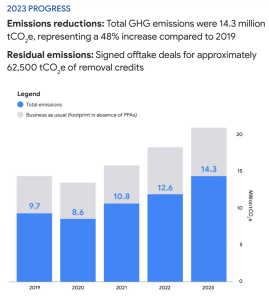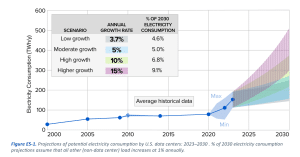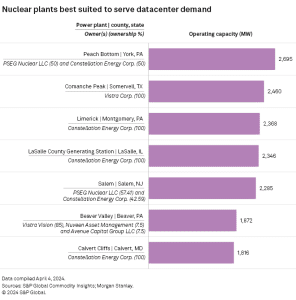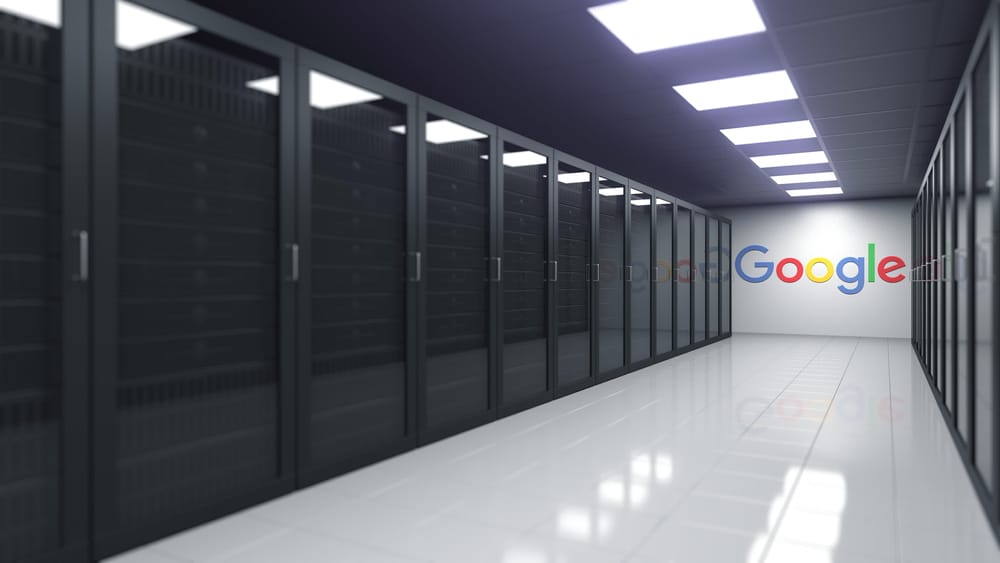Google is considering nuclear energy as a potential solution to meet its ambitious 2030 net-zero emissions goals, according to CEO Sundar Pichai. In a recent interview with Nikkei, Pichai revealed that the company is exploring various clean energy investments. These particularly include traditional renewables like solar and innovative technologies such as small modular nuclear reactors.
This move is part of Google’s strategy to reduce its carbon footprint while addressing the growing energy demands of its expanding artificial intelligence (AI) operations.
Google’s Energy Dilemma: AI vs. Carbon Emissions
In 2023, Google’s total greenhouse gas (GHG) emissions rose to 14.3 million tCO2e as seen below. This marks a 13% year-over-year increase and a 48% rise from the 2019 base year. And it has been growing since 2020.

This increase in emissions was mainly driven by higher energy use in data centers and supply chain emissions. As Google expands AI integration, its emissions reduction efforts face greater challenges due to the rising energy demands of AI computing and increased infrastructure investments.
The tech giant’s goal is to cut 50% of its combined Scope 1, 2, and 3 emissions by 2030. Pichai acknowledged the challenge posed by data centers and AI, which has significantly increased the company’s energy consumption.
Google’s global network includes over 25 strategically located data centers, selected based on key factors like land availability, infrastructure, local talent, and potential impact. These centers are essential in meeting the growing digital demands of the world, ensuring efficient data processing and storage.
- In 2023, Google’s data centers consumed 24 TWh of electricity, making up 7-10% of the global data center electricity usage, estimated between 240-340 TWh. Despite maintaining a 100% renewable energy match, data center energy use grew by 17%.
Additionally, the AI-driven company piloted renewable diesel for backup power in select U.S. and European data centers to reduce emissions. The big tech also plans to scale the initiative globally as renewable diesel becomes more available. This effort aims to lower the carbon footprint of their diesel backup power systems.
Can Google’s 2030 Carbon-Free Dream Stay on Course?
Google aims to power all its data centers with 24/7 carbon-free energy by 2030. The company also targets to replenish 120% of the freshwater it uses and achieve Zero Waste to Landfill across its data center operations by the same year.
These ambitious goals align with the company’s broader sustainability efforts to reduce environmental impact and support a cleaner future. However, Pichai emphasized the challenge of having this goal, saying that:
“It was a very ambitious target, and we are still going to be working very ambitiously towards it.”
AI’s energy demands are immense. A single ChatGPT inquiry consumes nearly 10x the energy of a typical Google search, and generating images requires over 60x more energy than text.
To meet these growing needs, some tech companies are turning to nuclear power. This shift reflects Big Tech’s challenge of balancing energy consumption with prior commitments to reduce emissions and tackle climate change.
AI data centers are expected to demand even more electricity in the coming years, further complicating Google’s net-zero goals.
According to the Electric Power Research Institute, data centers could consume over 9% of the nation’s electricity by 2030—more than double current levels. This growing demand has made it critical for tech companies like Google to explore alternative energy sources like nuclear power.


Why Small Nuclear Reactors Might Be Big Tech’s Next Bet
While Pichai did not specify when or where Google would begin using nuclear energy, the tech giant is following a path already taken by other major companies.
Earlier this year, Amazon announced a deal with Talen Energy to use power from the Susquehanna nuclear plant in Pennsylvania. This nuclear facility is capable of generating 960 megawatts of power—enough to supply about 1 million homes.
Similarly, Microsoft is working with Constellation Energy to restart the Three Mile Island nuclear plant, a site known for the worst nuclear accident in U.S. history. Constellation is seeking $1.6 billion in federal funding to reopen the plant by 2028, pending approval from the Nuclear Regulatory Commission.
Nuclear power presents a viable solution for providing reliable, continuous baseload power, traditionally dependent on fossil fuels. As the tech sector shifts towards carbon neutrality or net zero, onsite nuclear energy becomes an ideal choice for data centers, efficiently and sustainably meeting their growing energy needs.
According to S&P Global Commodity Insights, the best nuclear plants that could power data centers include:


Echoing the other tech company’s nuclear power sentiment, Pichai noted:
“We are now looking at additional investments, be it solar, and evaluating technologies like small modular nuclear reactors, etc.”
The tech giant aims to operate on 24/7 carbon-free energy (CFE) by 2030, covering every hour and grid where it functions. The strategy focuses on three initiatives: purchasing carbon-free energy, advancing new and existing technologies, and transforming the energy system through policy changes, partnerships, and advocacy. This approach will help Google slash its Scope 2 emissions, which it controls directly.
As energy demand continues to outpace renewable energy production, nuclear power is increasingly being viewed as a viable option for tech companies aiming to balance sustainability with the operational needs of their AI-driven data centers. Google’s move toward nuclear energy could significantly shift the tech industry’s approach to clean energy solutions.

